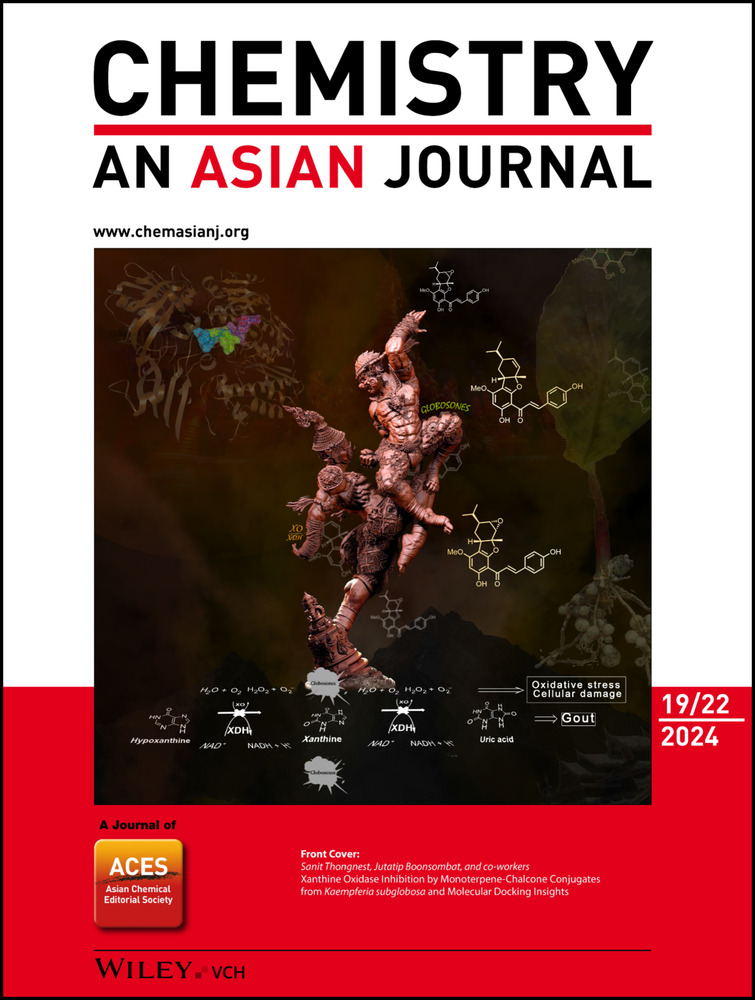通过C=Se键裂解反应简单快速地获得膦取代铜(I)-卡宾配合物
IF 3.5
3区 化学
Q2 CHEMISTRY, MULTIDISCIPLINARY
引用次数: 0
摘要
膦配位铜(I)- n杂环碳配合物是一种高效的催化和发光材料。在本研究中,通过高效的C=Se活化方案,报道了一种温和和可持续的方法来处理铜(I)-碳膦配合物。配合物[(Py^NHC)Cu(PPh3)2]X, X=BF4 (1), ClO4 (2), PF6(3)和OTf (4);用相应的铜(I)前体和三苯基膦处理1-异丙基-3-(吡啶-2-基)-咪唑-2-酰基,合成了Py^NHC=3-异丙基-1-(吡啶-2-基)-咪唑-2-酰基[(Py^NHC)Cu(PPh3)(X)]、X=Br(5)和I(6)。在这种合成策略中,n -杂环碳烯在室温下通过C=Se键裂解反应从n -杂环selone转移,在5分钟内形成铜(I)配合物。此外,还对C=Se键裂解反应的机理进行了全面的研究。这些反应对湿气和氧气不敏感。本文章由计算机程序翻译,如有差异,请以英文原文为准。
A Simple and Fast Access to Phosphine-Substituted Copper(I)-Carbene Complexes via C=Se Bond Cleavage Reaction
The phosphine-coordinated copper(I)-N-heterocyclic carbene complexes have emerged as an efficient material in catalysis and light-emitting applications. In this study, a gentle and sustainable approach to the copper(I)-carbene phosphine complexes are reported through an efficient C=Se activation protocol. The complexes [(Py^NHC)Cu(PPh3)2]X, X = BF4 (1), ClO4 (2), PF6 (3) and OTf (4); Py^NHC = 3-isopropyl-1-(pyridin-2-yl)-imidazol-2-ylidene, and [(Py^NHC)Cu(PPh3)(X)], X = Br (5) and I (6) have been synthesized by treating 1-isopropyl-3-(pyridin-2-yl)-imidazole-2-selone with corresponding copper(I) precursors and triphenylphosphine. In this synthetic strategy, N-heterocyclic carbene gets transferred from N-heterocyclic selone through a C=Se bond cleavage reaction to form copper(I) complexes within five minutes at room temperature. In addition, the mechanism responsible for the C=Se bond cleavage reaction has been fully investigated. These reactions are not sensitive to moisture and oxygen.
求助全文
通过发布文献求助,成功后即可免费获取论文全文。
去求助
来源期刊

Chemistry - An Asian Journal
化学-化学综合
CiteScore
7.00
自引率
2.40%
发文量
535
审稿时长
1.3 months
期刊介绍:
Chemistry—An Asian Journal is an international high-impact journal for chemistry in its broadest sense. The journal covers all aspects of chemistry from biochemistry through organic and inorganic chemistry to physical chemistry, including interdisciplinary topics.
Chemistry—An Asian Journal publishes Full Papers, Communications, and Focus Reviews.
A professional editorial team headed by Dr. Theresa Kueckmann and an Editorial Board (headed by Professor Susumu Kitagawa) ensure the highest quality of the peer-review process, the contents and the production of the journal.
Chemistry—An Asian Journal is published on behalf of the Asian Chemical Editorial Society (ACES), an association of numerous Asian chemical societies, and supported by the Gesellschaft Deutscher Chemiker (GDCh, German Chemical Society), ChemPubSoc Europe, and the Federation of Asian Chemical Societies (FACS).
 求助内容:
求助内容: 应助结果提醒方式:
应助结果提醒方式:


